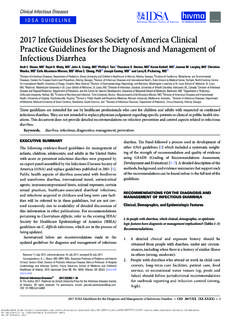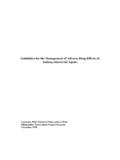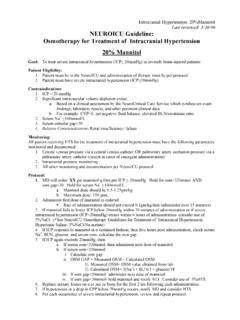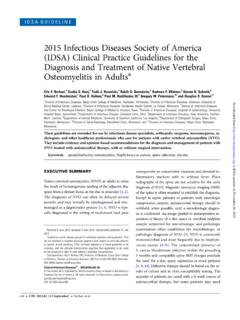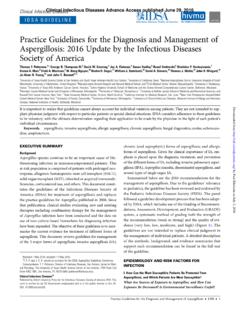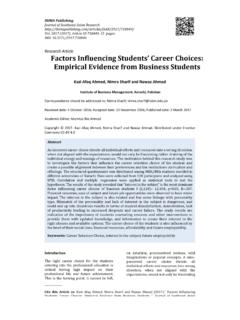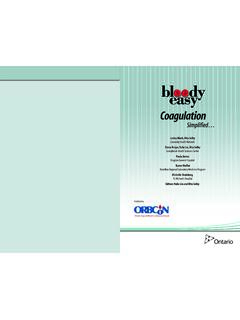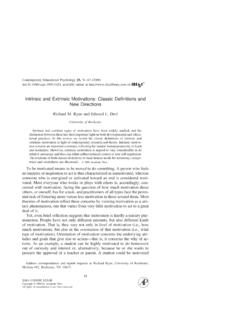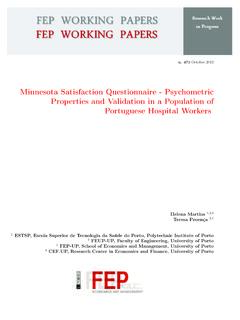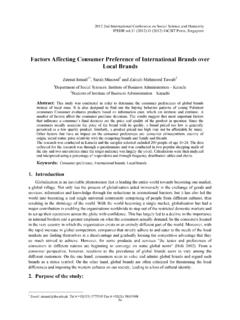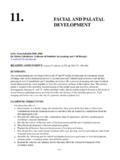Transcription of 40711 Manual - University of Pennsylvania
1 ;;;;;;;;;;;;;;;;;;;;;;;;;;;;;;;;;. W O U N D C L O S U R E M A N UA L. WOUND HEALING. WOUND C LOSURE M ANUAL. SUTURES. TO V I E W T H E E - C ATA L O G G O T O T H E. NEEDLES H E A LT H C A R E P R O F E S S I O N A L SECTION OF. W W W. E T H I C O N . C O M. ADHESIVES. SURGICAL MESH. ETHICON, INC. , PO BOX 151, SOMERVILLE, NJ 08876-0151. * TRADEMARK. SM. ETHICON, INC.. 2005, ETHICON, INC. PREFACE. T. his Manual has been prepared for the medical professional who would like to learn more about the practice of surgery the dynamics of tissue healing, the principles of wound closure, and the materials available to today's practitioners. Most important, it touches on some of the critical decisions which must be made on a daily basis to help ensure proper wound closure. ETHICON PRODUCTS, a Johnson & Johnson company, is the world's leading marketer of surgical sutures and is the only company that offers an adhesive with microbial protection as an alternative to sutures for topical skin closure.
2 ETHICON enjoys a reputation for developing quality products to enhance the lives of patients and for providing outstanding service to customers. We hope you find this Manual useful. But, above all, we hope that it reflects our high regard for the men and women who have chosen the medical profession as a career. ~ ETHICON PRODUCTS. ~. CONTRIBUTING EDITOR. David, L. Dunn, , Ph. D. Jay Phillips Professor and Chairman of Surgery, University of Minnesota We thank Dr. Dunn for his contributions to the Wound Closure Manual . Dr. Dunn is currently the Jay Phillips Professor and Chairman of Surgery at the University of Minnesota. This department has a long-standing tradition and has attained national and international recognition for excellence in training academic general surgeons and surgical scientists. He is also the Division Chief of General Surgery, Head of Surgical Infectious Diseases, Director of Graduate Studies, and Residency Program Director of the Department of Surgery.
3 Dr. Dunn has published over 400 articles and book chapters in the areas of Surgical Infectious Diseases and Transplantation. He has received regional and nationwide recognition in several academic organizations and is a Past-President of the Surgical Infection Society, the Association for Academic Surgery, the Minnesota Chapter of the American College of Surgeons, the Society of University Surgeons and the Society of University Surgeons Foundation. TABLE OF CONTENTS. WOUND HEALING Knot Tying .. 24. 1 AND MANAGEMENT Knot Knot Tying Techniques Most Often Used .. 24. 25. The 2 Square Knot .. 25. Recovery of Tensile 2 Surgeon's or Friction Knot .. 26. Patient factors that Affect Wound 2 Deep Tie .. 26. Surgical 4 Ligation Using a Hemostatic Clamp .. 26. Classification of 5 Instrument Tie .. 26. Types of Wound 6 Endoscopic Knot Tying Techniques .. 26. Healing by Primary 6 Cutting the Secured Sutures .. 26.
4 Healing by Second 7 Suture Removal .. 26. Delayed Primary 7 Suture Handling Tips .. 27. Suture Selection Procedure .. 27. Surgery within the Abdominal Wall 28. 2 THE SUTURE Closing the Abdomen .. Closing Contaminated or Infected 30. 40. What is a Suture?.. 10. Personal Suture 10. Suture Characteristics .. 11 3 THE SURGICAL NEEDLE. Size and Tensile 11. Monofilament vs. Multifilament .. 11 Elements of Needle Design .. 42. Absorbable vs. Nonabsorbable 12 Principles of Choosing a Surgical 44. Specific Suturing 13 Anatomy of a Needle .. 45. Synthetic Absorbable Sutures .. 14 The Needle Eye .. 45. Nonabsorbable Sutures .. 16 The Needle Body .. 46. Synthetic Nonabsorbable 17 Straight Needle .. 46. Common Suturing 18 Half-Curved Needle .. 47. 18 Curved 47. The Primary Suture 19 Compound Curved Needle .. 47. Continuous 19 The Needle Point .. 48. Interrupted 22 Types of Needles .. 48. Deep 22 Conventional Cutting 49.
5 Buried Sutures .. 22 Reverse Cutting Needles .. 49. Purse-String 22 Side Cutting 50. Subcuticular 22 Taper Point Needles .. 50. The Secondary Suture 23 Taper Surgical Needles .. 51. Stitch 23 Blunt Point 52. Needleholders .. 52. Needleholder 52. Placing the Needle in Tissue .. 53. Needle Handling Tips .. 53. PRODUCT TERMS. 4 PACKAGING 7 AND TRADEMARKS. An Integral Part of the Product .. 56. RELAY* Suture Delivery System .. 56. Modular Storage 56. Dispenser 57. Primary Packets .. 57. 8 PRODUCT INFORMATION. E-PACK* Procedure Kit .. 59. Expiration 60. Suture Sterilization .. 60. Anticipating Suture 61. Sterile Transfer of Suture 61 9 INDEX. Suture Preparation in the Sterile 62. Suture Handling 63. 5 TOPICAL SKIN ADHESIVES. DERMABOND* Topical Skin 68. OTHER SURGICAL. 6 PRODUCTS. Adhesive 74. Indications and 74. Application .. 74. After Care and Removal .. 74. Skin Closure Tapes .. 75. Polyester Fiber 75.
6 Umbilical Tape .. 75. Surgical Staples .. 75. Indications and Usage .. 76. Aftercare and Removal .. 76. PROXIMATE* Skin 76. Looped Suture .. 77. Retention Suture Devices .. 77. CHAPTER 1. WOUND HEALING. AND MANAGEMENT. 2 WOUND HEALING & MANAGEMENT. THE WOUND point of rupture, relating to the thickness of tissue, the presence of nature of the material rather than edema, and duration (the degree to Injury to any of the tissues of its thickness. which the tissue has hardened in the body, especially that caused Breaking Strength The load response to pressure or injury). by physical means and with required to break a wound regard- interruption of continuity is defined less of its dimension, the more as a Though most often PATIENT factors THAT. clinically significant measurement. AFFECT WOUND HEALING. the result of a physical cause, a Burst Strength The amount of burn is also considered a wound. The goal of wound management pressure needed to rupture a Both follow the same processes is to provide interventions that viscus, or large interior organ.
7 Towards the restoration to efficiently progress wounds through health otherwise known The rate at which wounds regain the biologic sequence of repair or as strength during the wound healing regeneration. The patient's overall process must be understood as a health status will affect the speed of Wound healing is a natural and basis for selecting the most the healing process. The following spontaneous phenomenon. When appropriate wound closure material. are factors that should be considered tissue has been disrupted so severely by the surgical team prior to and that it cannot heal naturally during the procedure. 2,3,4. RECOVERY OF. (without complications or possible TENSILE STRENGTH. disfiguration) dead tissue and AGE With aging, both skin Tensile strength affects the tissue's foreign bodies must be removed, and muscle tissue lose their tone ability to withstand injury but is infection treated, and the tissue and elasticity.
8 Metabolism also not related to the length of time it must be held in apposition until the slows, and circulation may be takes the tissue to heal. As collagen healing process provides the wound impaired. But aging alone is not accumulates during the reparative with sufficient strength to withstand a major factor in chronic wound phase, strength increases rapidly but stress without mechanical support. healing. Aging and chronic it is many months before a plateau A wound may be approximated disease states often go together, is Until this time, the with sutures, staples, clips, skin and both delay repair processes wound requires extrinsic support closure strips, or topical adhesives. due to delayed cellular response from the method used to bring it to the stimulus of injury, delayed Tissue is defined as a collection of together usually sutures. While collagen deposition, and similar cells and the intercellular skin and fascia (the layer of firm decreased tensile strength in the substances surrounding them.)
9 Connective tissue covering muscle). remodeled tissue. All of these There are four basic tissues in the are the strongest tissues in the body, factors lengthen healing time. body: 1) epithelium; 2) connective they regain tensile strength slowly tissues, including blood, bone and during the healing process. The WEIGHT Obese patients cartilage; 3) muscle tissue; and stomach and small intestine, on the of any age have, excess fat at the 4) nerve tissue. The choice of other hand, are composed of much wound site that may prevent wound closure materials and the weaker tissue but heal rapidly. securing a good closure. In techniques of using them are prime Variations in tissue strength may addition, fat does not have a rich factors in the restoration of also be found within the same blood supply, making it the most continuity and tensile strength to organ. Within the colon, for vulnerable of all tissues to trauma the injured tissues during the example, the sigmoid region is and infection.
10 Healing process. approximately twice as strong as the cecum but both sections heal at NUTRITIONAL STATUS . The parameters for measuring the Overall malnutrition associated the same rate. factors that affect strength of normal body tissue are: with chronic disease or cancer, tissue strength include the size, age, Tensile Strength The load per or specific deficiencies in and weight of the patient, the cross-sectional area unit at the CHAPTER 1 3. have debilitated immune systems. Some patients have allergies to FIGURE specific suturing materials, metal 1. alloys, or latex. These, on the RELATIVE other hand, will cause a height- TISSUE ened immune response in the STRENGTH form of an allergic reaction. This may also interfere with the healing process. Therefore, Lower respiratory the surgeon should always tract (Weak). Stomach check beforehand on a Duodenum (Weak) patient's allergies. (Strong). Small Cecum intestine CHRONIC DISEASE.
